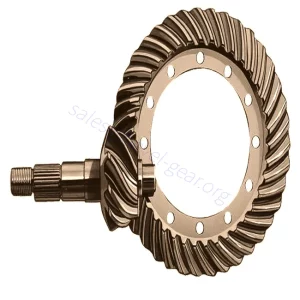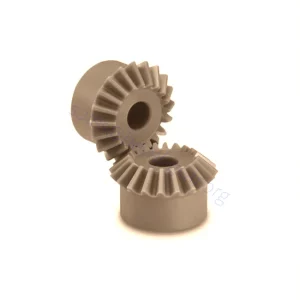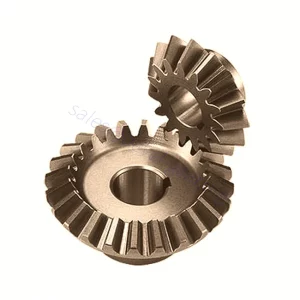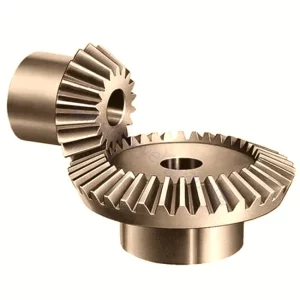Bevel Gears
Stainless Steel Forging Miter Bevel Gears
Bevel gears are typically constructed from metal or plastic. Bevel gears can be made of various types of materials with differing properties, such as aluminum, bronze, cast iron, brass, steel, hardened steel, and stainless steel. Plastic materials used to make bevel gears include Delrin, nylon, and polycarbonate.The bevel gear has many different applications such as marine applications, locomotives, printing presses, automobiles, cooling towers, steel plants, power plants, railway track inspection machines, etc.
As one of the leading bevel gear manufacturers, suppliers, and exporters of mechanical products, We offer bevel gear and many other products.Please get in touch with us for details.
Mail:[email protected]
This is a type of bevel gear with a gear ratio of 1:1, meaning the driver and driven gears have the same number of teeth. The purpose of this type is limited to changing the axis of rotation. It does not produce any mechanical advantage. Usually, miter gears have axes that intersect perpendicularly. In some assemblies, the shafts are aligned to cross at any angle. These are known as angular miter bevel gears. Shaft angles of angular miter bevel gears can range from 45° to 120°. Miter bevel gear teeth cuts can be straight, spiral, or Zero.
A miter bevel gear is part of the bevel gear family designed to work in pairs and with both gears having identical dimensions and number of teeth. Miter bevel gears are designed for applications where the rotational speed of the input and output drives remains constant but the direction changes. Generally, the difference in drive/output orientation in miter bevel gear sets is 90°, although sets are available which produce a selection of angular deviations. Miter bevel gears are available in either spiral or straight toothed configurations. Miter bevel gears are better suited to high-speed applications such as power tools and machine drives. Straight-cut miter bevel gears are suitable for low-speed applications such as door opener mechanisms and hand tools.
Miter bevel gear sets are used in machinery designs requiring changes in drive direction while maintaining drive speeds. These criteria are achieved by employing a set of cone-shaped gears of identical size, profile, and tooth number. This design allows the gears to be positioned in an opposed orientation while maintaining a constant speed relationship between the two drives. In the majority of cases, the miter bevel gear turns the output drive at right angles to the input. Gear sets can, however, be designed to affect almost any directional deviation. These gears fall into two basic categories: spiral or straight cut. This terminology refers to the angle that the teeth of the gear cut at in relation to the face or cone angle. Spiral cut gears are more appropriate for high-speed applications because the curve of the teeth allows for gradual engagement. This reduces the amount of “clashing” when the teeth of the two gears engage and make the gear train stronger and quieter. This type of gear is commonly used in high-speed applications such as lawn trimmers where the motor and driveshaft are orientated at right angles to one another.
A straight-cut miter gear is more suitable for slow-speed applications such as hand-operated door openers and hand tools. In these applications, the straight cut gears’ shortcomings are less noticeable, and the reduced cost of production makes their use attractive. Miter gear materials are dictated by their intended end use with hard-faced, high carbon steel appropriate for high load and high-speed applications. Nylon and various injection molding resins are used for gears that don’t work as fast or as hard. The close relationship between individual gears means that both gears in a set should ideally be replaced together even if only one is worn or damaged.




